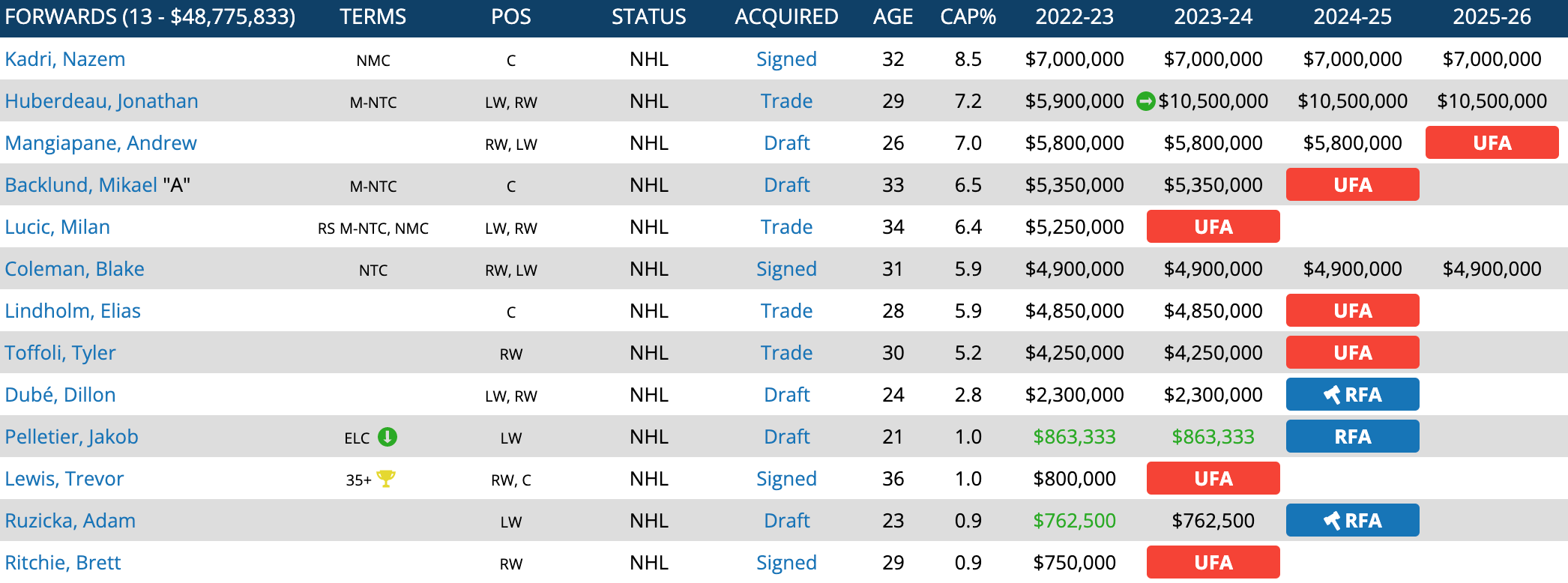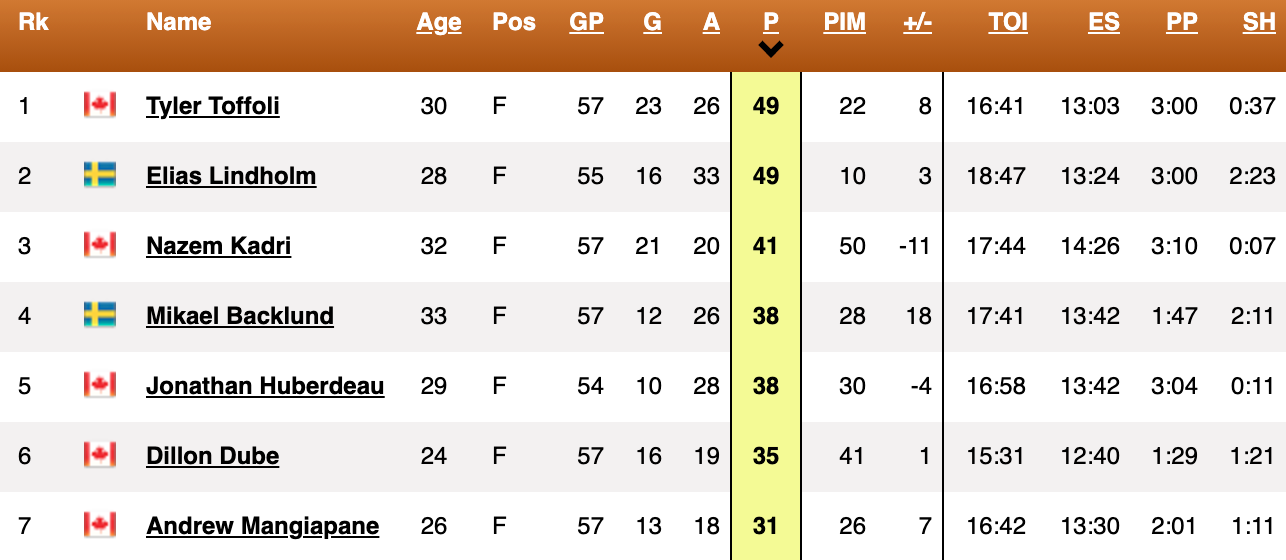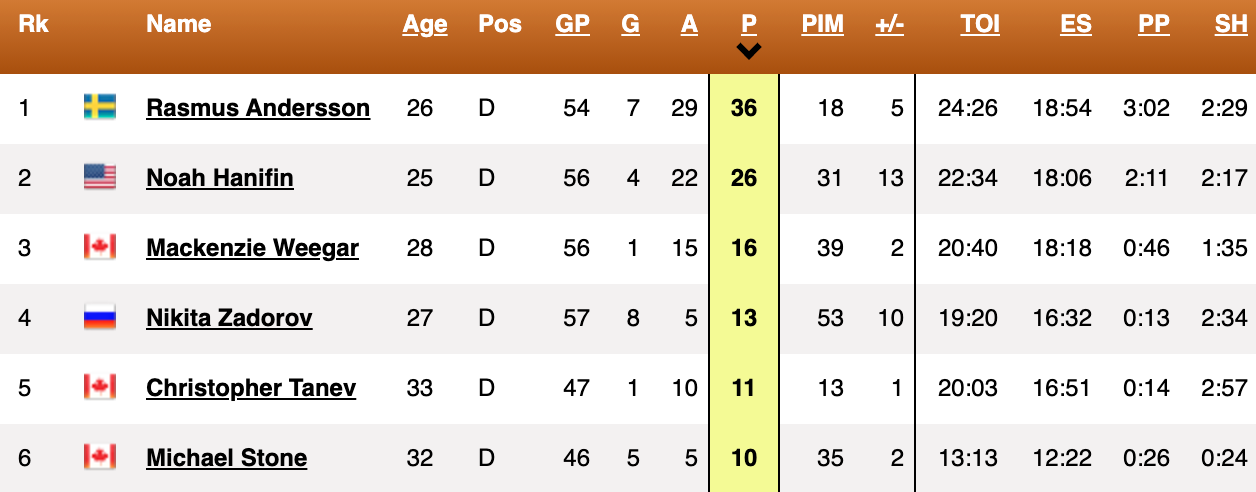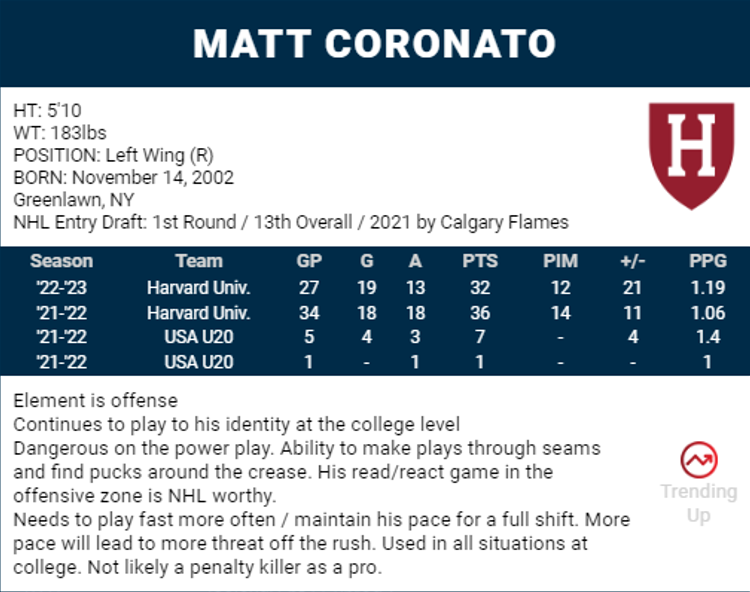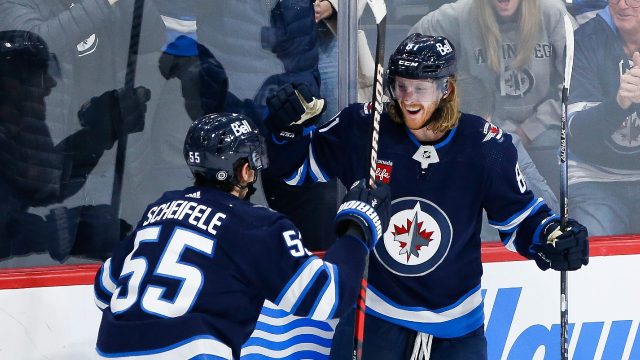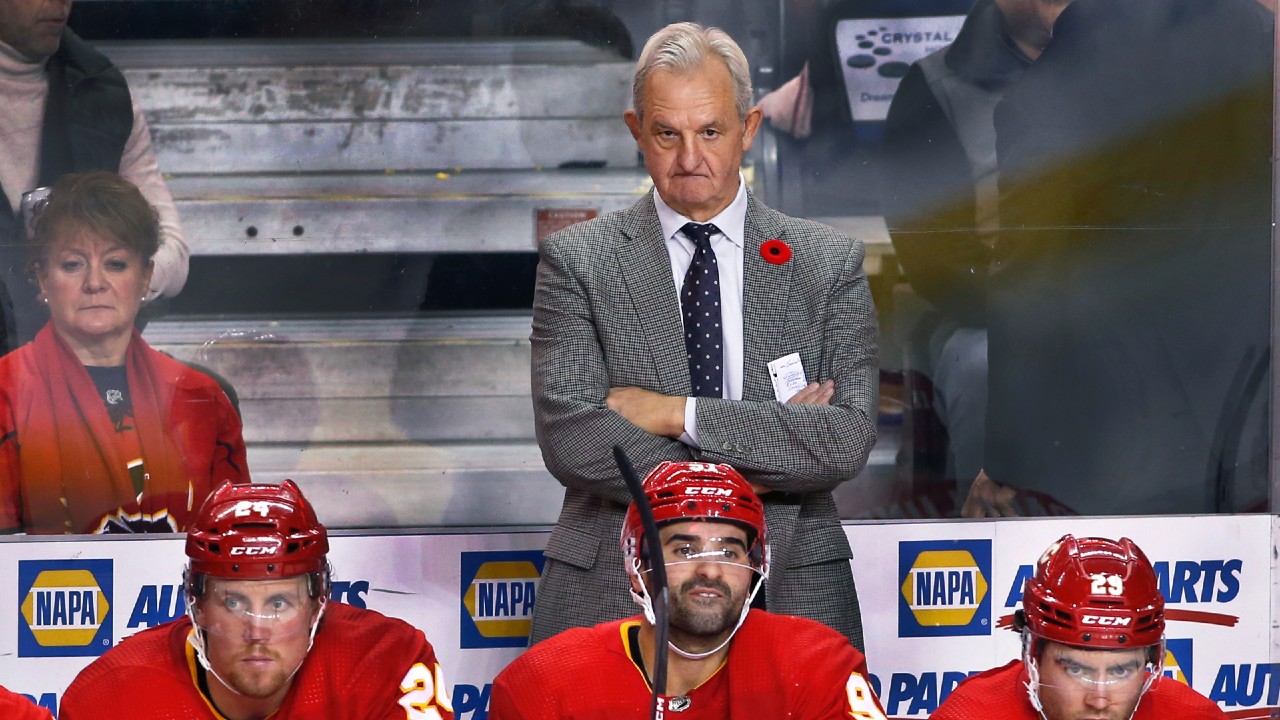
Continuing our deep dives into Canadian NHL franchises, their organizational depth and the plan moving forward, it’s time to look at the Calgary Flames.
The Flames have been difficult to understand for stretches this season. On paper, they shouldn’t be a borderline playoff team, but that’s exactly what they are at this stage of the year. And now we’re hitting the stretch drive.
I recognize not everyone wants to read “fancy” stats – or have to digest numbers when having honest discussions about NHL teams. Unfortunately, I have no choice when it comes to the Flames. Some of the numbers simply can’t be ignored, and display the reason(s) the team finds itself riding waves of inconsistency.
Here’s my deep dive into the state of the Calgary Flames:
FORWARD CONTRACTS
• Nazem Kadri’s contract expires at the end of the 2028-29 season and carries a full no-movement clause until the end of 2025-26. In the last three years of his contract he can submit a 13-team no-trade list.
• Jonathan Huberdeau’s extension kicks in at the beginning of the 2023-24 season and has a full no-movement clause until the end of the 2028-29 season. In the last two years of the contract Huberdeau can submit a 12-team list that he is willing to be traded to.
• Blake Coleman’s contract expires at the end of the 2026-27 season. He has a no-trade clause that expires at the end of the 2023-24 season. In the last three years of his deal, he can submit a 10-team list that he is willing to be traded to.
• Milan Lucic, Trevor Lewis, and Brett Ritchie are pending UFAs after this season.
DEFENCE CONTRACTS
• Noah Hanifin has an eight-team no-trade list included in his contract.
• Chris Tanev has a 10-team no-trade list in his deal.
GOALIE CONTRACTS
• Jacob Markstrom’s contract includes a full no-movement clause.
DRAFT CAPITAL
• The 2023 draft is very deep. The Flames look like a team that could finish anywhere between 14th and 20th in the overall league standings. If they elect to use their first round pick in a trade I imagine they would lottery protect it for this draft cycle, meaning they would have to expose a future first round pick (lottery-wise).
• If the Flames finish, say 20th overall, their first-round pick has more value than a pick from a team finishing deeper in the standings. In an odd sort of way, Calgary is better armed to use their first-round pick (value-wise) than some other teams.
As I get into the deep dive with this roster, I can’t help but come off sounding a bit terse with my assessment. In my opinion, the group has underachieved to date. They need more from several players. I have also identified some holes in the roster — ones that need to be addressed to maximize the way Darryl Sutter wants, and expects, the team to play.
NHL FORWARDS
Jonathan Huberdeau: I have witnessed the growth of Huberdeau’s game first-hand over the past 10 years (from my time working in Florida with the Panthers). He has more to give. His game looks tense. He’s at his best when maximizing his creative mind. Huberdeau has always been more of a distributor than a shooter, but there have been several nights this year that he has passed up Grade A chances to get pucks on goal. If the Flames are going to have playoff success his game has to go to another level. He’s capable of playing 20 minutes a game at even strength and the power play.
Tyler Toffoli: Give him credit, Toffoli’s game continues to be reliable. He consistently contributes his share offensively. He averaged .86 points per game last season and is averaging .84 points per game this season. The team knows what his limitations are. He’s not the fastest player in the NHL, but he plays to an identity Calgary can trust.
Elias Lindholm: Has mostly played to his identity this season. He’s hovering (close to) a point per game and being used in all situations. Not much has changed with his game. He’s not a high-end, top-line player, but he is certainly a high end second line forward. Lindholm is proficient in the face-off circle. He wins nearly 57 per cent of his draws.
Nazem Kadri: Calgary needs more from Kadri as well. His stats, across the board, are way down compared to last season (1.22 PPG in 2021-22 compared to .72 PPG in 2022-23). It speaks to the fact he isn’t a top line player who can produce high end offence when matched up against opponents’ first lines or primary checking units. Not only do the Flames need more offensively from Kadri, they also need more growl and attention to detail. He’s a minus-10 so far this year, and only winning 47 per cent of his face-offs. He, like Huberdeau, has more to give.
Mikael Backlund: On pace for his best scoring year in five seasons. He’s a solid third line NHL forward who can slide into a top six role at times if required. He’s used in all situations, brings reliable compete on a nightly basis, leads the team with a plus-18 rating and wins 52 per cent of his face-offs.
Dillon Dube: Overall, Dube has taken a positive step forward this season. He’s already eclipsed his career high in points and has a chance to score 45-plus overall. He’s used in all situations, plays quick and fast, and isn’t shy. Dube is fifth on the Flames with 89 hits. He’s turning into a solid third line player who, also, can slide into a top six role when asked.
Andrew Mangiapane: Mangiapane hasn’t found success with his linemates this season. His statistics have dropped off significantly. His shooting percentage last season was 18.9 and he scored 35 goals. This season his percentage has fallen to a career low 9.8 resulting in only 13 goals. I consider Mangiapane a shooter more than a playmaker. He needs to find more pucks in high danger areas, present more drive overall, and cash in on his chances more often down the stretch. There’s a theme developing with some of the Flames players. He, too, has more to give.
Blake Coleman: Coleman averages 15 minutes of ice time at even strength and the penalty-kill. He plays quick and fast. He’s contributed 11 even strength goals and 15 even strength assists. Coleman also has some push back in his game. He’s a plus-13 and wins 50 per cent of his draws. He’s one of the more reliable Flames forwards in my opinion.
Milan Lucic: He leads the Flames forwards with 122 hits. Lucic averages 11:37 of ice time and is used at even strength. There are nights he isn’t enough of factor or presence. The team hasn’t been playing to a consistent identity, which further exposes a player like Lucic, who has has four goals and nine assists on the season. His off the puck detail and tracking back defensively hasn’t been good enough on some nights. Lucic would have a tough time making the lineup of some other contending teams in the league right now.
Adam Ruzicka: Ruzicka can be an enigma at times. He’s a big, strong, powerful forward with good mitts and offensive instincts. He’s chipped in offensively (6G, 14A) in the 41 games he has played so far this season. Projecting between 40 and 45 points from Ruzicka at this time of his career is actually positive and indicates an upward trend. If he can grasp the fact he has to play quicker, faster, and with more consistent push in all three zones, he’s still young enough (23) to play a larger role in the future. There are nights, unfortunately, that his energy and compete fall below NHL standard. When he’s in the lineup he averages 12 minutes of ice time and is used at even strength and one of the Flames’ power-play units.
Trevor Lewis: Some nights he has trouble keeping up with speedy opponents. He’s a depth player who contributes a secondary layer offensively (8G, 7A), kills penalties, and averages 12 minutes of ice time. One of the positives is the fact he isn’t shy about playing with physical push back. Lewis is fourth on the Flames with 106 hits.
Brett Ritchie: Is a big body/power forward who plays a simple two-way game. He can work the wall down low in the offensive zone and wear down opponents physically. He is what he is – a fringe NHL depth forward.
GETTING A LOOK
Jakob Pelletier has surpassed the 10-game mark on the season and has one goal and one assist so far, averaging 13:38 of ice time and getting a chance on one of the Flames’ power-play units. He’s a work in progress, but is one of the young prospects Calgary is counting on to evolve in the future. It’s going to be difficult, however, to earn a ton of ice time down the stretch, unless he spikes offensively.
Matthew Phillips barely played in the two games he was dressed. He’s a proven AHL scorer who could have some value at the deadline. A team looking to add, at worst, organizational depth might be willing to flip a pick to the Flames and see where it goes. I get the feeling Calgary isn’t a fit for Phillips in the long run. Calgary is without a fifth-round pick in the upcoming draft. I’m not convinced they would get a fifth for Phillips, but it’s worth the ask. If you aren’t going to use the player, try to recoup something in return for his development time with your group. It’s wise asset management.
NHL DEFENCEMEN
Rasmus Andersson: Andersson is arguably the most complete player on the Calgary Flames roster. He logs a ton of ice time in all situations, is a consistent threat offensively on the power-play, and defends with purpose. The Flames’ coaching staff can rely on him to compete every night. He’s second on the Flames with 93 shot blocks. No NHL player is perfect. There are nights that Andersson turns some pucks over like anyone else in the league, but overall he’s been by far their top defender this season for me and is taking his game to another level.
Noah Hanifin: Logs big minutes in all situations and moves very well. He’s capable with the puck and provides secondary offence. Hanifin averages over 22 minutes per game and his minutes are generally match-up shifts versus the best the opponent has to offer. He’s a plus-13 defensively and is extremely important to this team.
MacKenzie Weegar: The learning curve has been evident with Weegar. He has taken time to adjust to the way the Flames structure their game plan. His ice time is down compared to what he was playing in Florida, but he is still averaging almost 21 minutes per game and being used in all situations. It’s been a mix of good, average, and not so good for Weegar. He is capable of asserting himself more physically and executing better overall. Another player with more to give.
Nikita Zadorov: I love when Zadorov gets an opponent in his tracks, gaps up, and finishes his checks with anger and authority. He could end up with 10 goals this season, which would easily be a career high. Zadorov averages just over 19 minutes per game and matches up against middle six opponents. I’m fine with the way Zadorov has played this season. His element is easy to identify. He’s a big, strong, physical defender who is mostly simple with the puck and leads the team with 126 hits.
Chris Tanev: Tanev is a warrior. He’s going to be sore, for years, after his career comes to an end. The Flames need him to be healthy for the stretch drive (somehow). He averages 20 hard minutes per game and leads the team in blocked shots (95). Everyone knows what Tanev brings to the team.
Michael Stone: Stone is a bottom pairing NHL defender. He moves well, has a bomb from the point, and is generally responsible. He matches up well versus bottom six opponents. What makes his role, potentially, replaceable is the fact he isn’t overly physical for his stature. Stone only has 52 hits on the season. He does, however, have 55 shot blocks as well. His contract has provided very good value for the Flames ($750,000).
NHL GOALIES
Jacob Markstrom: I’m not going to sugarcoat this – he simply needs to be better. Last season Markstrom contributed a 2.22 GAA and .922 save percentage. This year has been a struggle (2.93 GAA, .889 SV%). There have been nights he hasn’t started on time and allowed a goal he’d like to have back in the opening five minutes. There have also been nights the team needed a big save late in the game and didn’t get one from Markstrom.
Dan Vladar: It might surprise people to read Vladar’s stats are actually down from last season. He posted a 2.79 GAA and .906 SV% last season, compared to 2.79 GAA and .901 SV% this season. He’s found ways to win games for the Flames, however, and is being tasked with getting results versus higher end opponents. He’s going to be an important contributor down the stretch for the Flames, given the ups and downs of Markstrom’s game.
TWO PROSPECTS
Dustin Wolf: Wolf is in his second full season at the AHL level playing for the Calgary Wranglers. He has won 63 games in his first 86 starts. This year his goals-against average is 2.16 and his save percentage is .929. Wolf was drafted in the seventh round in 2019 and he’s not a “new breed” NHL goalie in terms of his stature (6-feet tall). The bottom line, though, is that he stops the puck. He’s athletic, has quick feet, and never quits on the play. He’s an NHL goalie on the horizon.
Matt Coronato: Coronato is having another solid season playing for Harvard. Here’s a look at his evaluation card and up to date stats:
INTERESTING FACTS
The Calgary Flames have generally identified as one of the biggest, heaviest teams in the NHL the past few seasons. As I was dissecting the positives and negatives with this group some interesting conclusions became crystal clear:
• Last season the Flames blocked 956 shots, for an average of 11.65 per game. This season they have blocked 722 shots, averaging 12.66 per game.
• Team hits in 2021-22 totalled 1,836 (22 per game); this season the team has 1,347 hit (23 per game).
• Shots on goal per game last season: 35.46. Shots on goal per game this season: 35.40.
• Shots against per game last year: 28.95. Shots against per game this year: 27.28.
• Goals for per game in 2021-22: 3.54. Goals for per game in 2022-23: 3.14.
TRADE DEADLINE TARGETS
Ivan Barbashev: The St .Louis Blues forward plays an energy game and has the ability to contribute better than secondary offence. He has the skill set to be used in all situations and he can play the wing and the middle. Barbashev is the kind of player who can open up ice for his linemates with his tenacity. He scored 26 goals and 34 assists last season, which was a career high. I’m not sure he’s a 60-plus point player, but he is better than the 10 goals and 18 assists he’s posted this year. Barbashev is a pending UFA.
Luke Schenn: The Vancouver Canucks defenceman leads the NHL is hits with 258. He plays a simple, in your face, style. More importantly, he’s a leader on and off the ice. Schenn is also a pending UFA.
Adam Henrique: Henrique is a veteran forward who can play both the middle and the wing. He’s scored 19 goals in Anaheim this season, which would be third most on the Flames roster, and he plays a responsible three-zone game. Henrique is only minus-7 in Anaheim, which is impressive considering the team is minus-96 in goals for/goals against. Henrique has one more year left on his contract.
HYPOTHETICAL TRADES
ST. LOUIS TRADES: Ivan Barbashev (50 per cent salary retention)
CALGARY TRADES: 2023 second-round pick, 2024 sixth-round pick.
Note: Blues retain 50 per cent of Barbashev’s $2.25 million cap hit.
VANCOUVER TRADES: Luke Schenn
CALGARY TRADES: 2024 third-round pick, 2025 fifth-round pick
Note: Canucks retain 50 per cent of Schenn’s $850,000 cap hit.
ANAHEIM TRADES: Adam Henrique
CALGARY TRADES: Matthew Phillips, 2024 second-round pick
Note: Ducks retain 50 per cent of Henrique’s $5.825 million cap hit through next season
CLOSING THOUGHTS
I believe the Flames need to add some leadership and scoring to their team. I’m also torn about the fact this group hasn’t been able to string consistent efforts together for extended periods of time. GM Brad Treliving and his staff can only do so much. Eventually it’s up to the players.


